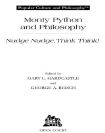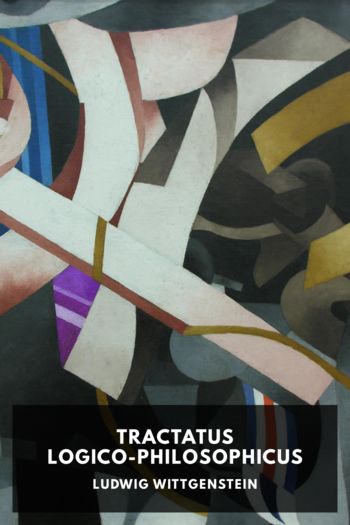Monty Python and Philosophy, Gary Hardcastle [portable ebook reader TXT] 📗

- Author: Gary Hardcastle
Book online «Monty Python and Philosophy, Gary Hardcastle [portable ebook reader TXT] 📗». Author Gary Hardcastle
The other Board members sit quietly through Palin’s impressive and important report. But, they need clarification about one of the more important points: “What was that about hats again?” one of them asks.
Distraction reigns again in Part IV, Middle Age, when the hyper-pleasant, smiley, and vapid American couple (Palin and, in drag, Idle) are served up a “philosophy conversation” in the form of flashcard prompts. The waiter (Cleese) tries to get the insipid couple started on their philosophy conversation by asking, “Did you ever wonder why we’re here?” They fail utterly to stay on topic. “Oh! I never knew that Schopenhauer was a philosopher,” Idle exclaims. Palin responds, “Yeah. . . . He’s the one that begins with an S.
WIFE: “Oh.”
HUSBAND: “Um [pause] . . . like Nietzsche.”
WIFE: “Does Nietzsche begin with an S?”
HUSBAND: “There’s an S in Nietzsche.”
WIFE: “Oh wow! Yes there is. Do all philosophers have an S in them?”
HUSBAND: “Yeah I think most of them do.”
WIFE: “Oh! Does that mean [the popular singer] Selina Jones is a philosopher?”
HUSBAND: “Yeah, Right. She could be. She sings about the meaning of life.”
WIFE: “Yeah, that’s right, but I don’t think she writes her own material.”
HUSBAND: “No. Maybe Schopenhauer writes her material?”
WIFE: “No. Burt Bacharach writes it.”
HUSBAND: “There’s no S in Burt Bacharach.”
If we combine this tedious conversation and the Boardroom’s fascination with hats, the results of Palin’s research begins to make sense. Human beings must “create” their “souls” day-by-day (rather than simply discover them, ready made) through “a process of guided self-observation.” The great enemy of this process, these sketches show, is distraction.
This is a conception of the soul that the Buddha could agree with. It embraces impermanence, avoids transcendentalist metaphysics, and accepts the view that we must actively cultivate our “souls.” This is the point of Buddhist “mindfulness” (sati)—a powerful meditation that cuts through the dehumanizing distractions. There’s nothing mystical or particularly fancy about it. You can do it in your daily activities as well as in isolated contemplation. It just requires you to focus your mind and senses in the present moment, and to resist the mind’s natural tendency to wander off into the past or future, to replay events or imagine scenarios that fill our minds with worries, regrets, hopes or cravings. Mindfulness is a state of awareness that comes from training and discipline, a state that shuts out the drifting distractions of life and reveals the uniqueness of each present moment. In doing this careful attending, one can become more present in his or her own life. Mindfulness helps to rehumanize a person by taking their head out of the clouds. And according to Buddhism it reconnects us better with our compassionate hearts by revealing other human beings as just human beings. Once the distractions of trivia, or theoretical, transcendental, or ideological overlays are removed, we may become better able to know ourselves and compassionately recognize ourselves in others. We may even come to learn that, in fact, we should all wear more hats. But we will only know for sure if we are less distracted and more mindful.
9
Is There Life After Monty Python’s The Meaning of Life?
STEPHEN A. ERICKSON
Questions regarding the meaning of life have haunted humanity, for these sorts of questions yield little in the way of sustainable answers. Little, that is, unless we answer them by way of belief systems that are quickly taken for granted, becoming merely conventional and soon thereafter artificial: in short, through doctrines that are seldom satisfying.
It is therefore no surprise that the script of Monty Python’s The Meaning of Life proved to be enormously frustrating for the Pythons, so much so that it was their last major project together. Like religions themselves, the questions surrounding the meaning of life separated them, rather than brought them together. In the words of John Cleese, “The script lacked a central idea.”
But what would a central idea have looked like? Might it have been a specific one, like the idea that eating—or not eating—fish reveals life’s meaning? And to whom? The fish? Their consumers? Not very likely in either case. Something more general then? Perhaps a vantage point from which to understand competing accounts of life’s meaning? This sounds more promising, but also quite abstract and not at all comical. One doubts the Pythons would have pursued this. But we could pursue it, especially if the Pythons’ failure to do so may have been part of what flawed Monty Python’s The Meaning of Life. So let us look at some competing accounts of life’s meaning, accompanied, naturally, by Monty Python.
Life, the Journey: The Axial Answer
Especially in the West, life has been understood as a journey—from bondage to liberation, appearance to reality, confusion to insight, or darkness to light. Liberation, reality, enlightenment, or light are the destination, the goal. Our purpose in going there is to be liberated, to be made fully real and enlightened. According to many religions, the meaning of life is to get to this place. This kind of thinking is identified in philosophy as axial thinking, and we can talk in this context about the axial journey and about axial time, the temporal dimension of this journey. The German philosopher Karl Jaspers (1883-1969) coined this term in the twentieth century, construing the last 2,500 years or so as the playing out of the Axial Age and its picture of human life.54
This all sounds like very serious stuff. One can’t help but wonder how to go about making such a journey. And here the Python humor has its bite. As it turns out, the undertaking of “salvation” has, it seems, been handed over to institutions, chief among them organized religions, that have laid down rules and regulations to guide people to the “place of light.” As the Pythons were aware, institutions tend to institutionalize, rather than serve, their customers. They engaged especially the Christian way





Comments (0)